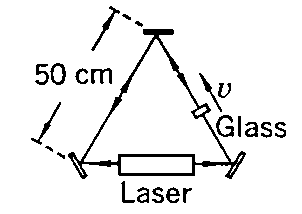
1. (1.2 Mould) Light from a distant star approaches the earth at an angle theta. The light enters the open end of a terrestrial telescope that is inclined at an angle theta-prime.
(a) Show that:
tan(theta-prime) = sin(theta) /[
where
(b) Find the expresion for tan(theta-prime), when v/c << cos(theta)
(c) Suppose
2. (1.4 Mould) Let the leg of the Michelson-Morley apparatus along the x -axis be equal to L1, and the leg along the y axis be equal to L2. The earth's velocity relative to the ether is v. Show that the fringe shift for a 90o rotation is: n = b2 (L1 + L2) / lambda where b = v /c. A 90o rotation is the difference in difference in phase shifts for the interferometer aligned with motion and rotated 90o.
3. (1.5 Mould) Michelson and Morley did not actually use a length L = 11 m in their apparatus. Both lengths ( L1 and L2) were folded back on themselves a number of times with mirrors. Show that if the length L1 is folded in two, with both parts along the x -axis, the time for light to go back and forth over the complete path is still equal to: t = 2 L1 / [c (1 - b2)] ~ 2 L1 (1 + b2)/c.
4. (1.6 Mould) Show that FitzGerald's contraction hypothesis explains the result of the Michelson-Morley experiment (limit your proof to the case L1 = L2). What happens if L1 is not equal to L2? Does FitzGerald's contraction still explain the experimental result?
5. ( 2-3 French) In a modern Fizeau experiment (see French for a description of the original experiment), a laser is in one arm of a triangular arrangement of mirrors (see figure). A slab of glass (n =1.5) 1 cm thick is inserted in another arm of the system. The laser light can travel in a closed path in either direction. When the slab is moved with a speed of 1 cm/sec in the direction indicated. What is now the optical path difference? (This difference which can be converted to an audible beat note if the samples of the counter-circulating beams are suitably combined in a detector.) Note: this differs importantly from the original Fizeau arrangement in that the boundaries of the medium change position while the light passes through. Your calculation must take account of this fact.
